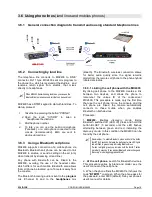
Note that if transmitting streaming audio,
monitoring must be limited to a brief listen to
check the signal, since the delay of the signal
will be annoying. The monitoring must be done
listening the direct audio of MX2400, using the
channel “Console”.
2.1.6
Program output
The MX2400 has two program outputs:
1. One monoaural program output, (PGM
MONO), balanced with XLR. The audio at
this output is processed to maintain
constant the audio level through the link.
2. One stereo program output (PGM STEREO)
unbalanced, with jack TRS ¼”. The signal at
this output is not processed, to maintain
intact the digital quality of the transmission.
This outputs send the program mix, that is to say, the
sum of signals of the 6 input channels (MIC-1 to
MIC-5, and Line/Bluetooth).
The stereo signal is formed by fixed panning of the microphone
channels, which are assigned to left, right and center as
indicated on the front of the console. The input LINE 6 is stereo.
More in “3.1.2 - Program controls and headphones"
The signal at the mono output is processed by a
dynamic range compressor that controls the peaks,
avoiding different levels on the air. The stereo output
is not compressed to preserve the natural sound for
broadcasting music.
Example of use:
These outputs can be connected to
a portable recorder to obtain high quality recordings,
or it can be sent to the studios using a high quality
radio link (eg digital microwave link).
2.1.7 USB (detection)
The MX2400 mixer-codec is designed for easy
connection with laptops, for transmission via Internet
using VoIP software (Skype or similar). The USB
connection solves the send and return the signal to
the Studios.
A mini-USB to USB-A male standard cable is used.
When you connect the MX2400 mixer to a computer
running Windows © XP/Vista/7, Linux or OS-X, the
operating system detects the console and install the
required drivers. No additional drivers are needed.
Windows
©
will use the USB device as the default
playback device. The MX2400 is detected as one
USB playback device (stereo) by which the computer
sends audio to the MX2400; and one USB recording
device, by which the computer receives audio from
MX2400.
ON USB DETECTION
Windows XP:
Check the output level in the Windows Mixer
("Programs → Accessories → Entertainment → Volume Control").
Windows 7:
Verify that the operating system has correctly
recognized the audio recording device. If Windows 7 erroneously
recognized as "microphone device" transmissions will be mono
(same signal on both channels). To fix it go to Control Panel →
Sound → Recording → select the USB device (shown as USB
microphone) and click [Properties]. Then select the tab "Advanced",
display the Recording Options menu and choose "2 channel, 16 bit,
44.1KHz."
2.1.8
Ethernet connection
The RJ-45 allows to connect the console to a LAN with
Internet access to send streaming; or to re-enter the
streaming to the MX2400's internal computer to get
Internet access via WiFi network or 3G/4G modem;
and to streaming to a streaming server or directly to the
studios of the radio station.
2.1.9
Telephone lines
RJ-11:
Connects the console to transmit using land-
line or wired cell phone via hands free (requires a
special adapter cable)
Bluetooth:
Links the console to a mobile phone via
Bluetooth. Cell phone can be up to 3 meters away.
2.1.10 Headphone outputs
There are 6 headphone outputs with female TRS
connectors (¼"). The signal on these outputs is a
headphones mix different from program. It has an
internal amplifier. The headphones can work in mono
or stereo.
Headphone bus combines the program signal, land
line return (RJ11 connector), Bluetooth return and
streaming return (not yet implemented).
The signal present at the TUNER input is sent to the fader
'STUDIO' when TUNER input is used, replacing the RJ-11
return (landline or cell phone wired).
SOLIDYNE
CODEC–MIXER MX2400
Page 10
Содержание MX 2400
Страница 2: ...SOLIDYNE CODEC MIXER MX2400 Page 2 ...
Страница 8: ...SOLIDYNE CODEC MIXER MX2400 Page 8 ...
Страница 14: ...SOLIDYNE CODEC MIXER MX2400 Page 14 ...











































